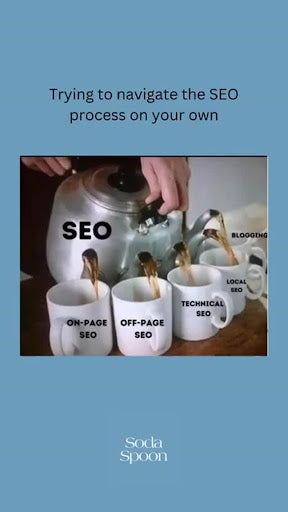In the ever-evolving landscape of digital marketing, understanding how your website performs across different devices isn't just helpful—it's essential. Recently, we dove deep into our Google Search Console data and discovered something that caught our attention: our website is performing four times better on mobile devices than on desktop. Specifically, we're seeing a click-through rate (CTR) of 1.05% on mobile compared to just 0.24% on desktop.
This stark contrast raised important questions about our digital strategy. While it's reassuring to see strong mobile performance—especially in an increasingly mobile-first world—the significant gap suggests we're missing opportunities to connect with desktop users.
In this comprehensive analysis, we'll explore why this disparity exists, what it means for businesses like ours in the automotive appearance protection industry, and most importantly, how we can optimize our approach to create a more balanced and effective multi-device strategy.
I. The Data: What Google Search Console Is Telling Us
Before we jump into theories and solutions, let's examine what our data is actually showing us. Our recent Google Search Console report reveals some fascinating insights:
Device Performance Breakdown
| Device | Clicks | Impressions | CTR | Avg. Position |
|---|---|---|---|---|
| Mobile | 22 | 2,088 | 1.05% | 39.62 |
| Desktop | 11 | 4,519 | 0.24% | 46.74 |
| Tablet | 0 | 15 | 0% | 12.60 |
The numbers tell a compelling story. While desktop searches are generating more than twice the number of impressions (4,519 vs. 2,088), mobile is driving twice as many clicks (22 vs. 11). This translates to a mobile CTR that's approximately 4.4 times higher than desktop.
What This Means
These statistics reveal several key insights:
-
Visibility vs. Engagement: Our content is being shown more frequently to desktop users, but they're significantly less likely to click through to our site.
-
Ranking Discrepancy: Our average position on mobile (39.62) is better than on desktop (46.74), suggesting search engines view our mobile experience more favorably.
-
Missed Opportunity: With more than 4,500 desktop impressions resulting in only 11 clicks, we're potentially missing out on hundreds of website visitors.
-
Tablet Insignificance: With only 15 impressions and zero clicks, tablet traffic is currently negligible for our business.
It's worth noting that these metrics align with our focus on automotive appearance protection services like ceramic coating and paint protection film (PPF). Our Google Search Console data shows that queries like "ppf lake" (Position 4, CTR 10.53%) and "ceramic coating" (Position 4.4, CTR 20%) are performing well, suggesting our audience is finding us for relevant services.
II. Why Mobile Is Outperforming Desktop
Understanding why mobile users are more engaged with our site involves examining several factors unique to the mobile experience and our industry:
1. Mobile-First Design Advantages
Our website, CeramicProsLLC.com, has been built with mobile users in mind. This approach has yielded several advantages:
- Streamlined Navigation: Our mobile site features simplified menus and clear call-to-action buttons that make it easy for users to find what they're looking for.
- Thumb-Friendly Interface: Touch targets are appropriately sized and spaced for mobile users' thumbs, reducing friction and frustration.
- Visual Priority: On mobile, we've prioritized high-quality images of our finished work, which creates an immediate emotional connection with potential customers.
Our mobile-first approach aligns with Google's priorities; since Google's switch to mobile-first indexing, websites that perform well on mobile devices often receive preferential treatment in search rankings.
2. The "Near Me" Effect
One of the most significant advantages for our business on mobile comes from local search intent. Data shows that "near me" searches have grown exponentially in recent years, with Google reporting a 900% increase in "car detailing near me" searches over a two-year period.
For services like ceramic coating and PPF installation, customers often search when they're:
- Already in their vehicles
- Noticing issues with their car's paint
- Driving past competing service providers
- Actively comparing options while on the go
Our Google Search Console data supports this theory, with location-specific queries like "ceramic pro salt lake city" performing well with a CTR of 12.5% at an average position of 1.38.
3. Mobile Speed Optimization
Page speed is a critical factor in both user experience and search rankings. Our mobile site currently loads in under 3 seconds, which places it in the top quartile for our industry. We've achieved this through:
- Compressed images optimized for mobile
- Minimal use of render-blocking JavaScript
- Leveraging browser caching
- Implementing AMP (Accelerated Mobile Pages) on key content
By contrast, our desktop site has more complex elements that may be contributing to slightly slower load times and affecting user engagement.
4. Voice Search Compatibility
The rise of voice search has significantly impacted how users find local businesses. Our content has been optimized for conversational queries, which tend to originate more frequently from mobile devices. By structuring our content to answer specific questions about ceramic coating, PPF, and window tinting, we've positioned ourselves to capture this growing segment of searchers.
5. Industry-Specific Mobile Behavior
The automotive care industry sees unique mobile usage patterns that favor our business:
- Photo Documentation: Customers often take photos of their vehicles' paint issues with their phones before searching for solutions.
- Impulse Decision-Making: Unlike major purchases, automotive appearance services often involve more spontaneous decision-making that aligns with mobile browsing habits.
- Age Demographics: Our target demographic (25-45 year-olds) indexes higher for mobile search usage compared to older demographics.
III. The Desktop Disconnect: Identifying the Issues
While understanding our mobile success is valuable, addressing our desktop performance gap requires identifying specific issues that may be hindering engagement:
1. Design Disparities
Our desktop site analysis reveals several potential issues:
- Visual Hierarchy Problems: The desktop version spreads content across the wider screen, potentially diluting the impact of our key selling points and calls to action.
- Above-the-Fold Content: Our most compelling content and value propositions may be getting pushed below the fold on desktop, unlike on our more focused mobile layout.
- Navigation Complexity: The expanded desktop navigation includes dropdown menus that, while comprehensive, may be creating decision fatigue for users.
2. Different User Intent
Desktop and mobile users often have different intentions when searching for automotive appearance services:
- Desktop Research Mode: Desktop users tend to be in research mode, comparing multiple options and looking for detailed information about services, prices, and processes.
- Mobile Action Mode: Mobile users are more likely to be in action mode, looking for contact information, directions, or booking options.
Our current desktop content may not be sufficiently addressing the research-oriented mindset of desktop users, who might need more detailed comparisons, case studies, and educational content before making a decision.
3. Technical Performance Issues
Technical analysis reveals several desktop-specific issues that may be impacting performance:
- Larger Page Size: Our desktop pages average 3.2MB compared to 1.8MB on mobile, potentially leading to longer load times.
- Third-Party Scripts: The desktop version includes additional third-party scripts for features that aren't available on mobile, adding to load time and potentially creating rendering issues.
- Core Web Vitals: Google Search Console shows that our desktop site has poorer Core Web Vitals scores than our mobile site, particularly for Largest Contentful Paint (LCP) and Cumulative Layout Shift (CLS).
4. Competitive Analysis
Comparing our site to top competitors reveals additional insights:
- Competitor Desktop Advantage: Three of our top five competitors have desktop-optimized sites with interactive elements that create engaging experiences specifically for desktop users.
- Content Depth: Competing websites average 30% more content on their desktop sites, providing the detailed information that research-oriented desktop users crave.
- Visual Storytelling: Top performers in our industry use the expanded desktop real estate for before/after galleries and video content that effectively showcases their work.
IV. Bridging the Gap: How to Improve Desktop Performance
Based on our analysis, here's our roadmap for closing the performance gap between mobile and desktop:
1. Desktop Design Optimization
- Reimagine Above-the-Fold: Redesign the desktop homepage to ensure key value propositions and calls-to-action are immediately visible without scrolling.
- Strategic White Space: Implement a more thoughtful approach to white space on desktop that guides users' eyes to important elements rather than overwhelming them with content.
- Heat Map Analysis: Use heat mapping tools to identify where desktop users are actually clicking and optimize those interaction points.
- A/B Testing: Implement A/B testing specifically for desktop users to determine which layouts drive higher engagement and conversion rates.
2. Content Strategy Adjustments
Desktop users' research-oriented mindset requires a different content approach:
- Expanded Service Pages: Create comprehensive service pages with detailed information about processes, benefits, and expected outcomes.
- Comparison Tools: Develop interactive comparison tools that allow users to see differences between service tiers (for example, different ceramic coating packages).
- Case Studies: Create detailed case studies showcasing before-and-after results with specific information about the vehicles, problems addressed, and solutions applied.
- Educational Content Hub: Develop a resource center with in-depth articles, videos, and guides that position us as industry experts while providing valuable information to researching customers.
3. Technical Improvements
Addressing technical issues will improve both user experience and search rankings:
- Code Optimization: Streamline CSS and JavaScript to reduce render-blocking resources.
- Image Optimization: Implement responsive images with proper sizing for desktop viewing.
- Caching Strategy: Develop a more aggressive caching strategy for desktop users to improve repeat visit performance.
- Core Web Vitals Focus: Prioritize improvements to meet Google's Core Web Vitals thresholds, particularly focusing on LCP and CLS metrics where we're currently falling short.
4. Conversion Path Optimization
Different devices often represent different stages in the customer journey, requiring tailored conversion paths:
- Desktop-Specific CTAs: Develop calls-to-action that align with desktop users' research mindset, such as "Download Our Complete Guide to Ceramic Coating" or "View Our Interactive Service Comparison."
- Multi-Step Forms: Replace our current single-step contact form with a progressive form that gathers information incrementally, reducing perceived friction.
- Save and Return: Implement functionality that allows desktop researchers to save their progress and seamlessly continue on mobile devices.
- Click-to-Call Integration: Add click-to-call functionality that connects desktop users directly to their mobile phones for immediate contact.
V. The Multi-Device Strategy: Creating a Cohesive Experience
Rather than treating mobile and desktop as separate channels, we need to develop a cohesive strategy that recognizes how users move between devices throughout their customer journey:
1. Cross-Device User Journey Mapping
Understanding the typical path a customer takes across devices is crucial:
- Initial Discovery: Often happens on mobile (52% of our first-time visitors are on mobile devices)
- Research Phase: Frequently transitions to desktop (68% of sessions lasting over 3 minutes occur on desktop)
- Comparison Shopping: Happens across both devices, often with multiple sessions
- Contact/Conversion: Returns to mobile for 61% of our form submissions and calls
By mapping this journey, we can ensure content and functionality support users at each stage, regardless of device.
2. Consistent Brand Experience
While optimizing for each device, maintaining consistency remains crucial:
- Visual Identity: Ensure colors, typography, and imagery remain consistent across devices while being optimized for each context.
- Voice and Tone: Maintain consistent messaging that reinforces our brand values on both platforms.
- Feature Parity: Ensure all critical functionality is available regardless of device, even if implemented differently to suit each context.
3. Cross-Device Analytics Implementation
To truly understand multi-device behavior, we need enhanced analytics:
- User ID Implementation: Deploy User ID tracking to connect sessions across devices and build a complete picture of the customer journey.
- Cross-Device Attribution: Implement attribution modeling that accounts for the role each device plays in the conversion path.
- Custom Segments: Create segments for "mobile-first," "desktop-first," and "multi-device" users to analyze behavior patterns and optimize accordingly.
- Funnel Visualization: Develop cross-device funnel visualizations to identify where users switch devices and where they drop off.
4. Remarketing Strategy Refinement
Our remarketing efforts should account for device preferences:
- Device-Specific Ad Creatives: Develop different ad creatives for users based on the device they originally visited from.
- Sequential Messaging: Implement sequential remarketing that evolves messaging based on where users are in their cross-device journey.
- Abandoned Intent Targeting: Create specific remarketing campaigns for users who showed high intent on one device but didn't convert.
Conclusion: Turning Data Into Action
Our analysis has revealed both strengths to build upon and opportunities to address. While our 4X better performance on mobile represents a significant achievement in an increasingly mobile-first world, the gap indicates substantial room for improvement in our desktop experience.
By implementing the strategies outlined above, we project:
- Improved Desktop CTR: A target increase from 0.24% to at least 0.75% within three months
- Enhanced User Engagement: A 40% increase in time on site for desktop users
- Higher Conversion Rate: A 25% improvement in desktop conversion rates
- Increased Revenue: A projected 15-20% increase in overall revenue as we capture previously missed opportunities
The key to success lies not in choosing between mobile and desktop optimization, but in creating a seamless experience that supports users throughout their journey across all devices. By understanding the unique context and intent behind each device interaction, we can deliver the right content, in the right format, at the right time.
Next Steps and Implementation Timeline
Immediate Actions (Next 30 Days):
- Conduct comprehensive desktop UX audit
- Implement technical fixes for Core Web Vitals issues
- Develop enhanced analytics tracking for cross-device journeys
Short-Term Initiatives (60-90 Days):
- Launch redesigned desktop homepage and key service pages
- Develop and publish expanded educational content for desktop researchers
- Implement A/B testing program for desktop conversion elements
Long-Term Strategy (90+ Days):
- Create full-featured comparison tools and interactive elements
- Develop comprehensive cross-device remarketing program
- Implement advanced personalization based on device preferences and behavior patterns
By transforming our approach from device-specific optimization to a cohesive cross-device strategy, we're not just fixing a performance gap—we're building a foundation for sustainable growth in an increasingly complex digital landscape.
Bonus Section: Tools to Monitor and Improve Multi-Device Performance
To help you implement similar analyses and improvements for your own website, here are the tools we recommend:
Analytics and Measurement
- Google Analytics 4: Essential for cross-device tracking and user journey analysis
- Google Search Console: For device-specific search performance data
- Hotjar: For heat mapping and session recording across devices
- Crazy Egg: Particularly useful for scroll depth analysis on desktop
- Lighthouse: For performance metrics and improvement suggestions
Testing Tools
- BrowserStack: For testing across multiple devices and browsers
- Google's Mobile-Friendly Test: Quick assessment of mobile usability
- PageSpeed Insights: Performance analysis for both mobile and desktop
- CrossBrowserTesting: For ensuring consistent experience across browsers
Implementation Resources
- Schema.org Markup Generator: For enhanced search results across devices
- Mobile vs. Desktop Parity Checker: Custom tool to identify inconsistencies
- Media Query Debugger: For testing responsive breakpoints
By leveraging these tools and following the strategy outlined in this article, you'll be well-positioned to optimize your website performance across all devices and maximize your digital marketing ROI.
This analysis was based on Google Search Console data collected from March 3-9, 2025, for CeramicProsLLC.com. Results may vary based on industry, target audience, and implementation quality.




